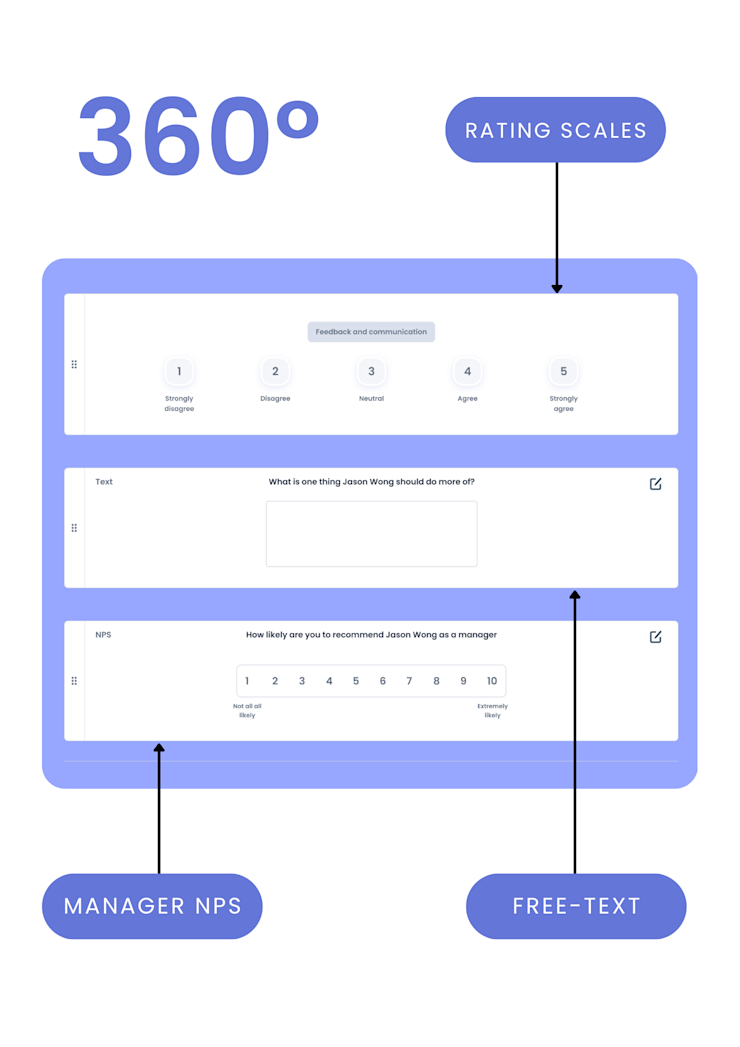Selecting the appropriate performance review rating scale for your company can be a daunting task as it requires finding a balance between objectivity and fairness, whilst considering your organisation's specific goals and culture.
With several types of rating scales available, it can be challenging to determine the most suitable one for your company's unique requirements. In this article, we'll explore the vital factors to consider when selecting a performance review rating scale and provide guidance on how to choose the most appropriate one for your organisation.
In this comprehensive guide, we'll assess the advantages and disadvantages of different types of rating scale, as well as offer advice for designing a system that meets your organisation's objectives.
You'll learn how to establish clear criteria for evaluating employee performance beyond just providing a numerical score. We’ll also discuss how to create quantitative assessments that go deeper than previous performance review cycles by focusing on growth mindset rather than past performance reviews.
By the end of this post, you will have gained valuable knowledge on how to rate employee performance effectively while avoiding bad rating data. You’ll be equipped with tools necessary to measure an employee's level of success against established criteria so they consistently meet expectations during future evaluations.
So, let's dive in!
Performance rating scale description / definition
Performance rating scales are used to assess employee performance in the workplace. They offer a means of gauging job-related abilities, behaviours, and qualifications.
Constructing a performance rating system necessitates contemplation of several elements.
What are the key goals and values of your company, and how should they be reflected in our performance review rating scale?
What specific skills, behaviors, and competencies do you want to measure, and how can a rating scale help you do this effectively?
How will the rating scale be used in your performance management process, and what role will it play in feedback and development strategies?
How will the rating scale be perceived by employees, and what impact might it have on their motivation and engagement?
What training and resources will be needed to implement the rating scale effectively, and how will we ensure that managers and employees are using it consistently and fairly?
How will you evaluate the effectiveness of the rating scale over time, and what mechanisms will be used to make changes or updates as needed?
What are the legal and ethical considerations related to using a performance review rating scale, and how will you ensure that you are complying with relevant laws and guidelines?
Quantitative rating scales
Quantitative rating scales are those that rely on numbers to measure an employee’s performance against predetermined standards.
For example, an employer may rate each employee’s customer service skills using a five-point scale ranging from “excellent” (5 points) to “poor” (1 point). A score of 4 would indicate that the employee meets expectations while a score of 2 indicates that they need improvement in this area.
This type of scale allows employers to quickly compare different employees' performances across various metrics and make informed decisions about their workforce as a whole.
Eletive 360° reviews are a great complement to qualitative reviews, providing a comprehensive and well-rounded view of an employee's performance from multiple sources. With the ability to gather feedback from colleagues, managers, and subordinates, the Eletive 360° feedback system allows for a holistic understanding of an employee's strengths and areas for improvement.

Qualitative rating scales
Qualitative rating scales are more subjective than quantitative ones and involve evaluating an individual's behaviour rather than specific tasks or objectives completed during their employment period.
These types of scales typically include categories such as teamwork ability, communication style, problem-solving abilities etc., which allow managers to get an overall picture of how well an individual works within the team environment rather than just focusing on individual accomplishments alone.
Performance review rating scales examples
Let's have a look at examples of the most commonly used performance review rating scales:
Numeric rating scale: A scale of 1 to 5 or 1 to 10 where the employee is given a rating based on their performance.
Behavioural rating scale: A scale that assesses an employee's behavior in the workplace, such as their ability to work in a team, communication skills, and work ethic.
Competency rating scale: A scale that assesses an employee's ability to perform specific job-related tasks, such as technical skills or customer service.
Critical incident rating scale: A scale that assesses an employee's performance based on specific incidents or events that have occurred during the review period.
Graphic rating scale: A visual scale that uses a set of criteria, such as attendance, quality of work, and attitude, to rate an employee's performance.
Self-rating scale: A scale that allows employees to rate their own performance and provide feedback on their strengths and weaknesses.
Peer rating scale: A scale that allows coworkers or colleagues to rate an employee's performance based on their observations and interactions with the employee.
Management by objectives (MBO) rating scale: A scale that assesses an employee's performance based on specific, measurable objectives that were established at the beginning of the review period.
4 steps to choosing the right performance review rating scale
Identify your company's goals and values: Determine what your company's goals and values are and how they relate to performance management. This will help you select a rating scale that aligns with your company's culture and objectives.
Determine what you want to measure: Consider what specific skills and behaviors you want to measure in your employees. For example, you may want to evaluate their communication skills, work ethic, or technical abilities. This will help you choose a rating scale that is tailored to your company's needs.
Consider the pros and cons of different rating scales: Evaluate the advantages and disadvantages of various rating scales, such as a numeric scale, behavior-based scale, or competency-based scale. Consider how each type of scale may impact the feedback and development of your employees.
Test and refine the rating scale: Test the rating scale with a small group of employees and assess its effectiveness. Gather feedback from managers and employees to identify any areas of improvement and refine the rating scale accordingly. Continuously monitor and adjust the rating scale as needed to ensure its effectiveness.
Performance review rating scale best practices
Here are some best practices for using performance review rating scales:
Always use clear and specific criteria: Clearly define the criteria for each rating level to ensure consistency and accuracy in the ratings. Use specific examples to illustrate what constitutes each level of performance.
Make sure to avoid bias: Use objective and measurable criteria to evaluate performance, and avoid personal biases or subjective opinions. Train managers and reviewers to be aware of their biases and to focus on objective data and facts.
Give regular feedback: Provide regular feedback throughout the review period, not just during the formal review process. This will help employees understand their performance expectations and make necessary improvements.
Have a collaborative approach: Encourage a collaborative approach where the employee and manager work together to set goals, review progress, and assess performance. This promotes transparency, accountability, and engagement.
Prioritise ongoing development: Use the performance review process as an opportunity for ongoing employee development. Identify areas where the employee needs improvement and provide resources and support to help them improve.
Ensure consistency: Ensure that the rating scale is consistently applied across the organization, with all employees evaluated on the same criteria. This helps to ensure fairness and avoid perceptions of favoritism.
Facilitate documentation: Document all performance reviews and ratings to provide a record of the employee's performance history. This can be useful for future reviews, promotions, and other HR decisions.
Related reading: Employee engagement surveys – the case for a 5-point Likert scale
Conclusion
With the right performance review rating scale, you can encourage employees to consistently meet expectations and foster a culture of growth and development in your organisation.

Book a demo to discover how Eletive can help you choose the right performance review rating scale for your company and measure employee engagement and performance. Take advantage of our advanced tools to increase productivity today!
What is the performance review rating 5 point scale?
The five-point performance review rating scale is a useful tool for measuring employee engagement and performance. With one representing the lowest and five indicating excellence, it provides a clear way for HR personnel to rate staff and compare performance. To ensure accuracy, HR managers should clearly define what each number represents and provide consistent guidance and training across departments. Blind reviews can help prevent bias, and detailed explanations of ratings should be given to provide context and feedback.
FAQ
What are the 5 scale performance rating options?
1. Excellent: This rating is given to employees who consistently exceed expectations and go above and beyond their job requirements.
2. Very Good: Employees receiving this rating have met or exceeded all expectations set for them in the workplace.
3. Satisfactory: Employees with this rating are meeting all of their job requirements, but may not be excelling at any particular area of work performance.
4. Needs improvement: These ratings indicate that an employee's performance needs improvement in order to meet expectations set by the company or team they are working on/for.
5 Poor: This is a failing grade and means that an employee’s performance has been subpar compared to what was expected from them in terms of quality, quantity, timeliness etc., and they need to take immediate action in order to improve.
What is a performance review rating 3 point scale
The 3-point performance review rating scale is a popular method for measuring employee engagement and performance. With three categories - excellent, satisfactory, and unsatisfactory - it provides a straightforward way for both managers and employees to evaluate performance. This system can be implemented in various ways, such as tallying exemplary work or asking employees to rate their own performance. Managers should ensure they provide detailed feedback and conduct regular check-ins to track progress.
What is the performance review rating 4 point scale?
The 4 point performance review rating scale is a versatile tool that HR managers can use to evaluate employee performance across a range of criteria. With clearly defined tiers, such as Unsatisfactory, Satisfactory, Good, and Excellent, managers can provide detailed feedback to employees, helping them to identify strengths and areas for improvement. To ensure fairness, comprehensive policies and guidelines should be established, and objective data, such as task completion rates and customer service reviews, should be used during the assessment process.

























